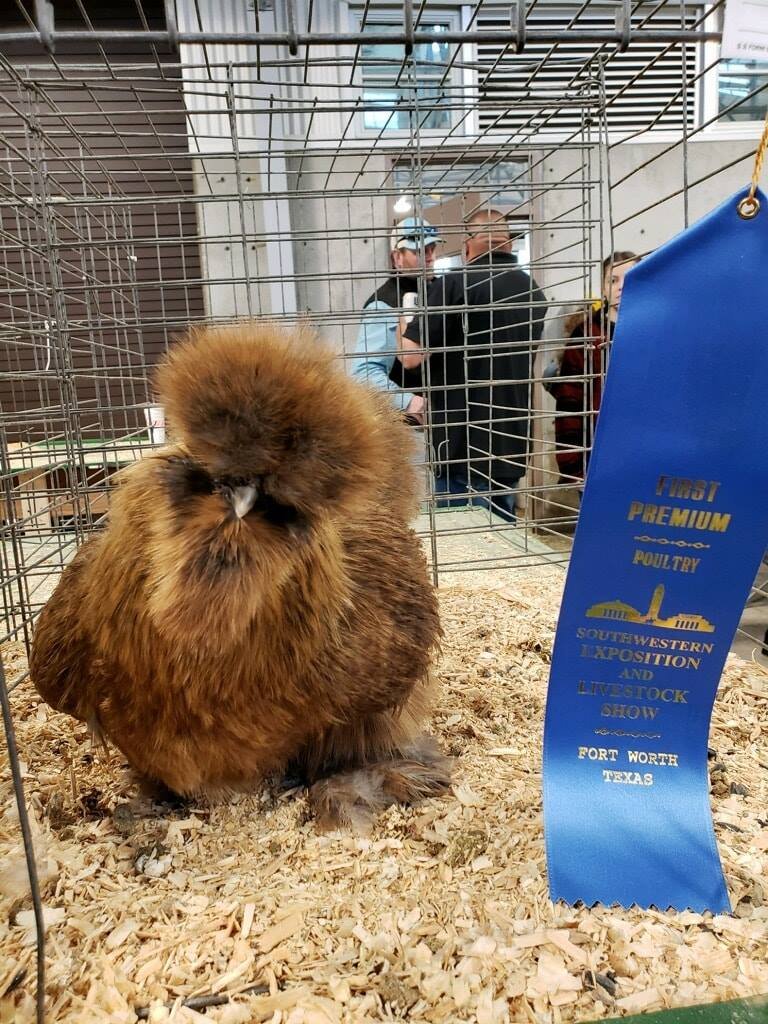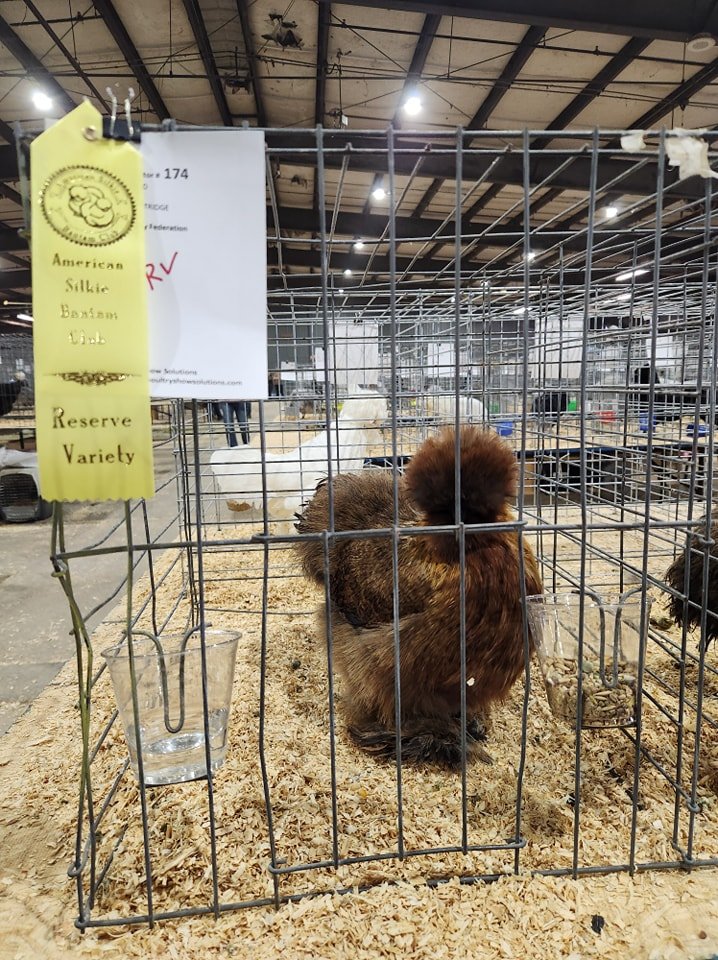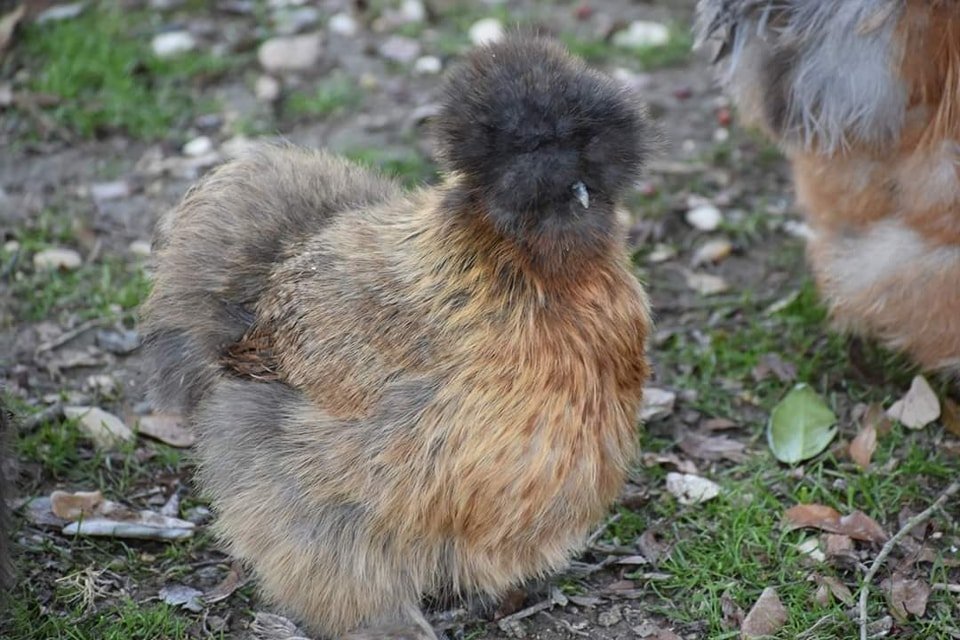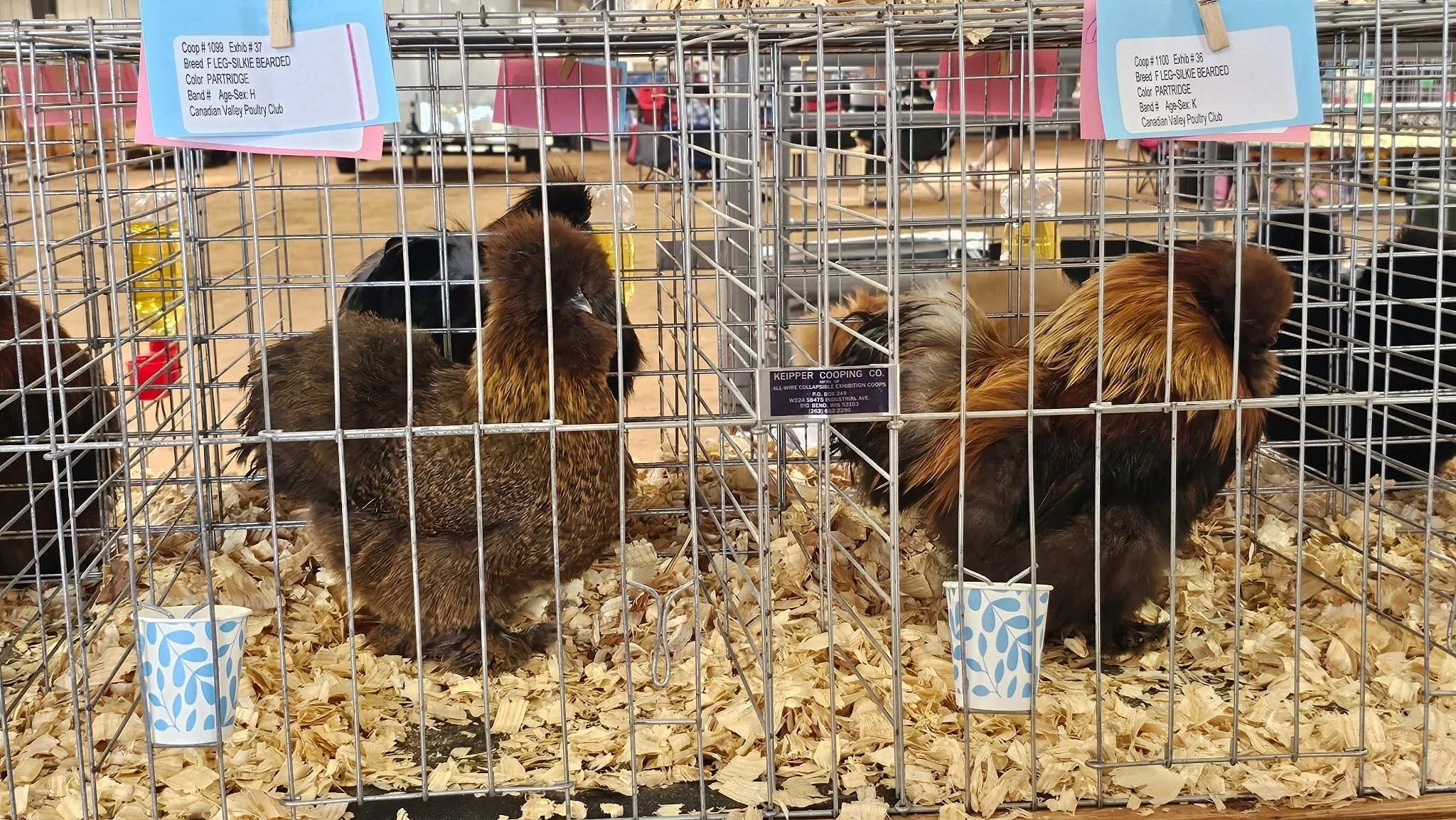 Image 1 of 6
Image 1 of 6

 Image 2 of 6
Image 2 of 6

 Image 3 of 6
Image 3 of 6

 Image 4 of 6
Image 4 of 6

 Image 5 of 6
Image 5 of 6

 Image 6 of 6
Image 6 of 6







Bearded Partridge Silkie Chicks
Bearded Partridge Silkie Chicks (Co-Bred with BSH Farms)
Our Bearded Partridge Silkies began in winter 2011 with birds from SD Ranch (Farmersville, TX)—they’ve since retired from poultry and now run a non-profit animal rescue/sanctuary. We worked that line for years (also developing Whites and Blacks alongside the Partridge). In 2018 we added a cock from Wendy Watkiss plus a satin pullet. A move in 2020 and a raccoon raid wiped out our Partridge flock, but in 2021 Wendy restarted us with two strong trios, and in winter 2024 she offered her entire Partridge flock to us and we purchased it. Partridge is probably the hardest variety we’ve ever raised: getting consistent lacing and deep mahogany—in both males and females—takes time and ruthless selection. Today we feel our Bearded Partridge Silkies rank among the nicest in the country; we rarely get beat unless it’s by a bird we bred and sent out. We offer chicks and eggs on a limited basis, and when available we ship started chicks at 3–4 weeks to give families a sturdier, easier start.
Quick facts (standard & variety)
Type: Bearded Silkie (Bantam); Variety: Partridge — recognized by APA & ABA.
Standard weights (ABA): Cock 36 oz, Hen 32 oz, Cockerel 32 oz, Pullet 28 oz.
Signature traits: Walnut comb; full crest with beard & muffs; five toes; dark skin & beak; turquoise blue ear lobes; feathered (muffed) feet.
Color goal: We’re proud that our line produces well-colored females (clean penciling/lacing) and males with the correct black breast and crisp mahogany in shoulder/saddle, with clean hackles.
Production & personality
Eggs: Small, cream to tinted; “fair” layers.
Broodiness: Excellent natural mothers—Silkies are famous for it.
Temperament: Exceptionally gentle and people-oriented; great for youth and small flocks.
Care notes for new breeders & youth
Keep runs dry and clean to protect muffed feet and maintain plume quality.
Provide sensible shade; sun can fade mahogany and wash penciling.
Trim around the eyes only if needed for vision (crests can obscure sight in some birds).
Color, chicks, and “surprises” (read this!)
Partridge is a management color: tone and pattern often sharpen after the first juvenile molts—some birds improve significantly with age.
Our Partridge pairings hatch about ~5% Blue Partridge and ~8% White. We cannot sort Blue-based chicks at shipping, but we will not send whites in Partridge orders—those are removed by default.
We cull hard for pattern, mahogany depth, correct male black breast, and type—even birds others think we’re “crazy” to cull—so what you receive is selected with the show pen in mind.
Terminology note: We use “muffed” to mean feather-footed (Silkies also have facial muffs and a beard). If you ever need help sexing youngsters or choosing which to grow on for color vs. type, we’re happy to advise.
What you’ll see in our pen
Full crests with tidy beards, soft yet abundant feathering, steady temperaments, and Partridge birds that hold mahogany and carry consistent penciling/lacing—with cocks showing the correct black breast—the kind that turn heads in the aisle and feel good in the hand.
Bearded Partridge Silkie Chicks (Co-Bred with BSH Farms)
Our Bearded Partridge Silkies began in winter 2011 with birds from SD Ranch (Farmersville, TX)—they’ve since retired from poultry and now run a non-profit animal rescue/sanctuary. We worked that line for years (also developing Whites and Blacks alongside the Partridge). In 2018 we added a cock from Wendy Watkiss plus a satin pullet. A move in 2020 and a raccoon raid wiped out our Partridge flock, but in 2021 Wendy restarted us with two strong trios, and in winter 2024 she offered her entire Partridge flock to us and we purchased it. Partridge is probably the hardest variety we’ve ever raised: getting consistent lacing and deep mahogany—in both males and females—takes time and ruthless selection. Today we feel our Bearded Partridge Silkies rank among the nicest in the country; we rarely get beat unless it’s by a bird we bred and sent out. We offer chicks and eggs on a limited basis, and when available we ship started chicks at 3–4 weeks to give families a sturdier, easier start.
Quick facts (standard & variety)
Type: Bearded Silkie (Bantam); Variety: Partridge — recognized by APA & ABA.
Standard weights (ABA): Cock 36 oz, Hen 32 oz, Cockerel 32 oz, Pullet 28 oz.
Signature traits: Walnut comb; full crest with beard & muffs; five toes; dark skin & beak; turquoise blue ear lobes; feathered (muffed) feet.
Color goal: We’re proud that our line produces well-colored females (clean penciling/lacing) and males with the correct black breast and crisp mahogany in shoulder/saddle, with clean hackles.
Production & personality
Eggs: Small, cream to tinted; “fair” layers.
Broodiness: Excellent natural mothers—Silkies are famous for it.
Temperament: Exceptionally gentle and people-oriented; great for youth and small flocks.
Care notes for new breeders & youth
Keep runs dry and clean to protect muffed feet and maintain plume quality.
Provide sensible shade; sun can fade mahogany and wash penciling.
Trim around the eyes only if needed for vision (crests can obscure sight in some birds).
Color, chicks, and “surprises” (read this!)
Partridge is a management color: tone and pattern often sharpen after the first juvenile molts—some birds improve significantly with age.
Our Partridge pairings hatch about ~5% Blue Partridge and ~8% White. We cannot sort Blue-based chicks at shipping, but we will not send whites in Partridge orders—those are removed by default.
We cull hard for pattern, mahogany depth, correct male black breast, and type—even birds others think we’re “crazy” to cull—so what you receive is selected with the show pen in mind.
Terminology note: We use “muffed” to mean feather-footed (Silkies also have facial muffs and a beard). If you ever need help sexing youngsters or choosing which to grow on for color vs. type, we’re happy to advise.
What you’ll see in our pen
Full crests with tidy beards, soft yet abundant feathering, steady temperaments, and Partridge birds that hold mahogany and carry consistent penciling/lacing—with cocks showing the correct black breast—the kind that turn heads in the aisle and feel good in the hand.